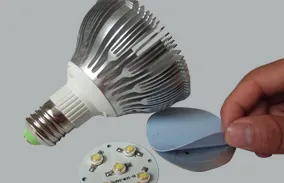Heat-dissipating silicone sheet is one of many thermal conductive materials. It is a gap-filling thermal pad made of silicone resin as the base material and added with temperature-resistant and thermally conductive materials. It has high thermal conductivity, low interface thermal resistance, and insulation. Because of its softer hardness, it can realize a smaller thermal resistance under low pressure, while eliminating the air between the contact surfaces and fully filling the rough surface between the contact surfaces to improve the contact The heat conduction effect of the surface. Because of the good filling effect of the heat-dissipating silicone sheet, it can effectively conduct the heat of the heat source to the shell, and the heat-conducting silicone sheet has good compressibility and elasticity, and can serve as a shock-absorbing pad.

Manufacturers of heat dissipation materials generally claim that their thermal conductivity materials can effectively reduce thermal resistance and improve thermal conductivity. In fact, thermal resistance here refers to contact thermal resistance, and the heat dissipation silicone sheet itself also has thermal resistance, so if the heat of the heat dissipation silicone sheet What impact will the increase in resistance have?
First, explain what is contact thermal resistance? Contact thermal resistance means that when heat flows through the interface of two solids in contact, the interface itself presents a significant thermal resistance to heat flow. We can imagine two objects with a smooth and smooth surface that are in good contact. The real contact is the part where the two contact each other. The other parts are gaps. The heat is transferred through the air in the gap, but its heat transfer capacity is far. It is not as good as a general solid material, so by adding a thermally conductive silicone sheet in the gap, air is removed as much as possible, and appropriate pressure is given to make the surface close to the thermally conductive silicone sheet to reduce the contact thermal resistance.
The heat dissipation silicone sheet itself has thermal resistance. If the thermal resistance of the material is too large when the heat passes through the heat dissipation silicone sheet, it will hinder the rate of heat transfer. Just like a runner facing multiple railings while running, he must If you avoid and move forward during running, the speed will definitely decrease. The same reason is that the thermal resistance is large. Therefore, the thermal resistance of the heat dissipating silicone sheet will increase, which will reduce its thermal conductivity and reduce the heat transfer efficiency.

 English
English
 usheenthermal
usheenthermal



